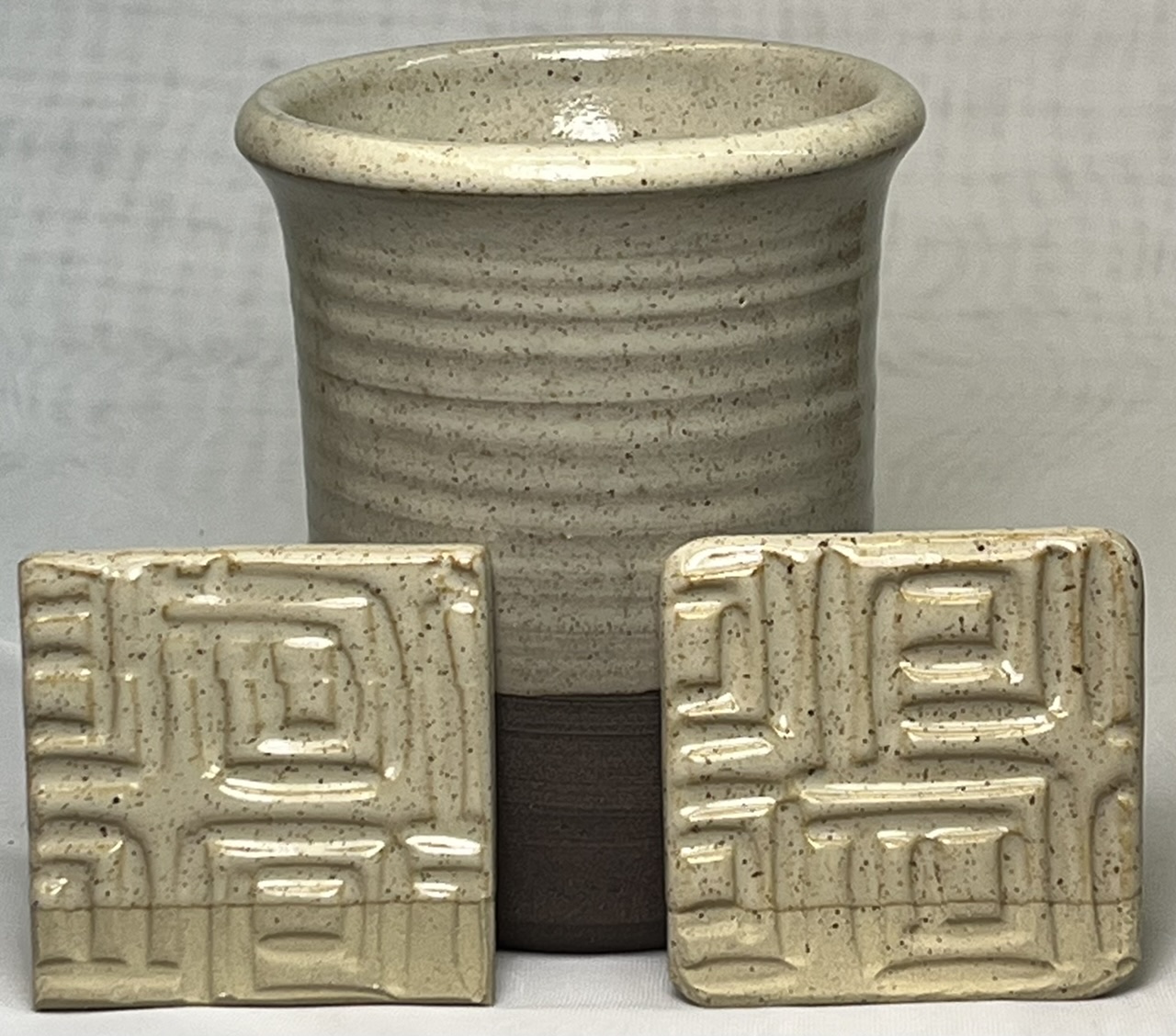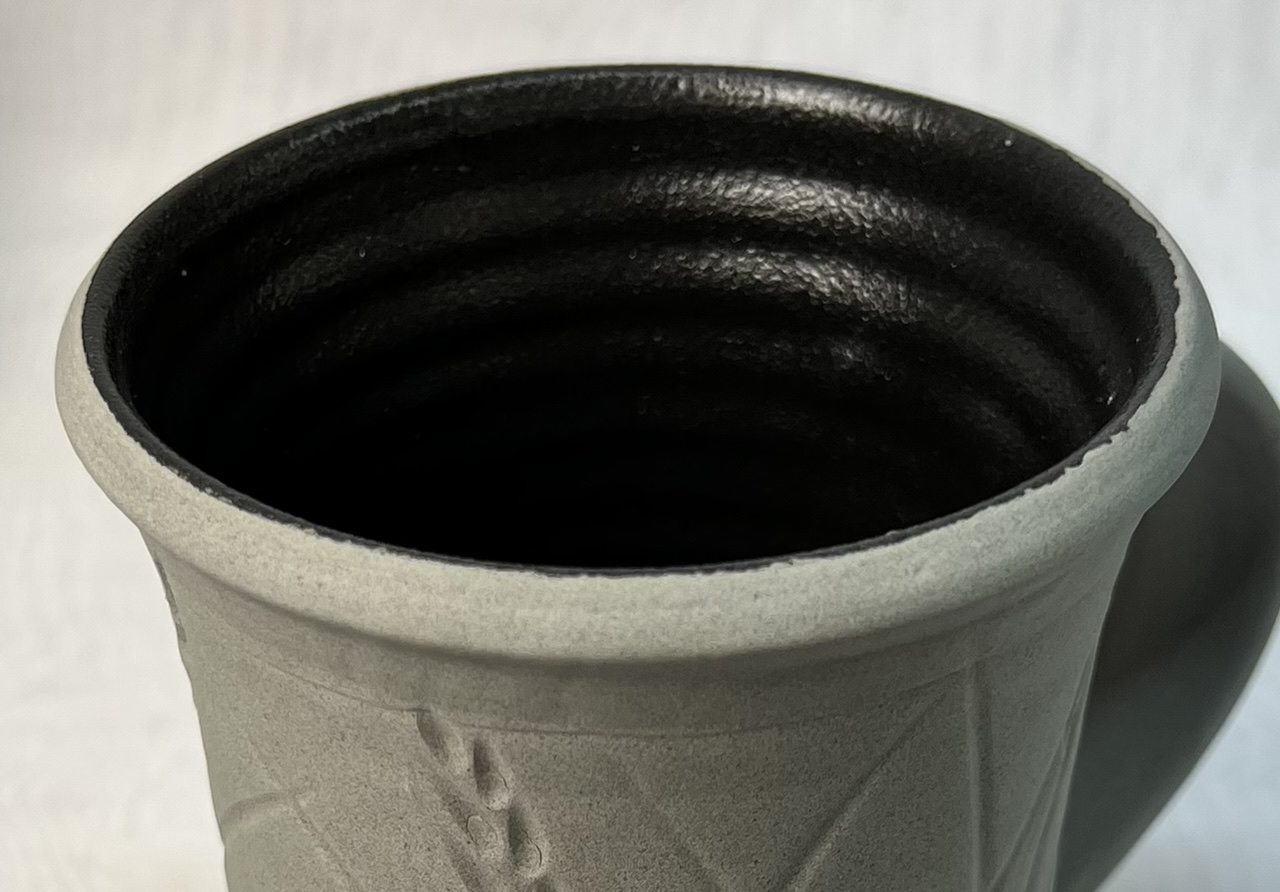Project Name
Matte:Gloss Blend to create Cone 5/6 glazes
Project Codenumber
UnAssigned
Notes
This project is intended to develop silky matte glaze variations using a base made from a mix of G2934 matte and G2926B glossy. Generally, G2934 fires too matte. But mixing in a small percentage of the gloss shines it up enough to get a silky surface. The rate of cooling in the kiln also affects the matteness developed, we are planning to use the C5DHSC or C6DHSC schedules and will tune the blend+variations to work there.
Cone 10 dolomite glazes are adjusted in dozens of ways (by colourant, opacifier and variegator additions), our plan is to transplant some of these mechanisms into this blend-base for trials at cone 5 and cone 6.
The G2934 base has low thermal expansion, it melts and flows well even though it is matte. And it can have a silky surface just like a cone 10 dolomite matte. That makes it well worth building variations on.
G2934:G2926B Oatmeal - Cone 6
|
Code # G3933 |
Batch # -2 |
| Materials | Amt |
|---|---|
| G2934 Matte Glaze (G2934) | 75.000 |
| G2926B Glossy Glaze (G2926B) | 25.000 |
| Additions | |
|---|---|
| Red Iron Oxide | 1.000 |
| Tin Oxide | 5.000 |
| Rutile | 1.200 |
Total:107.20
Auto Unity Formula
|
Si:Al: 6.8:1 5.9 (Molar:5.9) 11.3 Cost 9.47 per kg |
Notes
We have improved this recipe: G3933EF is Ravenscrag Slip based and is less prone to crawling.
This came from someone targeting the "fake Shino" effect in the Mid-Range Glazes book by John Britt. He transplanted the mechanism (the iron, rutile and tin oxide) into our G2934 matte base (with help from the G2926B glossy). While the effect fails as a shino, it does produce a nice oatmeal (a standard among middle-temperature potters). Of course, the proportion of glossy:matte can be adjusted.
We have mixed it as both a dipping and brushing glaze and used it for a couple of years. It works especially well on dark bodies. However, it does have issues with crawling, many pieces have to be touched up and retired (refiring does work well).
The richest color and best surface is achieved with a slow cool firing. The speckle depends on the iron agglomerates being maintained, so do not sieve it through more than 40 mesh, do not ball mill it and do not mix the slurry too long in a propeller mixer. Of course, granular manganese could be added or the glaze could be used on a speckle clay body.
If crawling is an issue a CMC gum addition might be needed. Adjust color by changing the percentage of iron oxide. Variegate more with more rutile.
Pictures
G3933 original photo from customer

The original photo, from the customer, of the glaze shivering on a black-burning body provided the motivation to try it. We were not able to duplicate the shivering, it fits all the bodies we have tried so far.
G3933 on Coffee clay, M340, M340GS

No sign of shivering out of the kiln or after iceboater:boiling water test. Our results look quite different. Using the C6DHSC firing schedule.
G3933 Oatmeal on M390 at Cone 5 slow cool

Using the C5DHSC firing schedule.
XML (to paste into Insight)
<?xml version="1.0"?> <recipes version="1.0" encoding="UTF-8"> <recipe name="G2934:G2926B Oatmeal - Cone 6" id="208086" key="Lg85siM1" date="2025-11-04" codenum="G3933"> <recipelines> <recipeline material="G2934 Matte Glaze" lookup="G2934" amount="75.000" tolerance=""/> <recipeline material="G2926B Glossy Glaze" lookup="G2926B" amount="25.000" tolerance=""/> <recipeline material="Red Iron Oxide" amount="1.000" added="true"/> <recipeline material="Tin Oxide" amount="5.000" added="true"/> <recipeline material="Rutile" amount="1.200" added="true"/> </recipelines> </recipe> </recipes>
Born: 2021-10-27, Modified: 2025-11-04 20:24:10
G2934 85:15 Adjustable Matte Black
|
Code # G2934BL |
Batch # -2 |
| Materials | Amt |
|---|---|
| G2934 | 85.000 |
| G2926B | 15.000 |
| Additions | |
|---|---|
| *Mason 6600 Black Stain | 6.000 |
Total:106.00
Auto Unity Formula
|
Si:Al: 6.5:1 5.9 (Molar:5.8) 12.4 Cost 9.49 per kg |
Notes
Attractive black matte glazes are among the most difficult of all effects to produce. Even slight differences in the degree of matteness are noticeable. Cutlery marking is very visible when the surface is too matte. The key to success is adjustability, both in recipe and firing schedule (more info below).
G2934 has long been our favourite matte recipe for cone 6. While it is OK on porcelains and in firings that cool quickly, is often too matte in firings that cool slowly (like heavily packed kilns). For bight colored versions of this base (e.g. orange, yellow, red) we have used the G2934Y base, it develops a more satin surface. But for black that does not work, it often fires too glossy, something you do not want.
Thus we add enough of the G2926BL glossy to tune the degree of matteness. In our kilns, an 85:15 blend works the best. If that fires too matte try 80:20. It might be best to mix a batch of both G2926BL and G2934BL, then pour them together in the desired proportion. Adjust according to the fired result.
Pictures
A stunning contrast between matte and gloss blacks

The clay is Plainsman M370. Fired at cone 6 using the PLC6DS drop-and-hold firing schedule. The inside glossy glaze is G2926BL. The outside glaze base is G2934BL matte. Both recipes contain 6% Mason 6600 black stain. G2934BL is tricky to keep consistent because the matte surface is a product of both the chemistry and the firing schedule. Thus we faced lots of testing when it became necessary to substitute Ferro Frit 3124 for the supposed equivalent, Fusion Frit F-19. Early results showed a little better melting, so the 10-15% glossy we normally add to move the stoney matte toward satin is not needed. However, we still made an 85:15 batch for our more frequent slow-cool C6DHSC firings (otherwise this G2934 mug would have fired too matte). So with the two recipes and two schedules I can produce four surfaces, from gloss satin to stony matte.
Which black base layer produces the best oil-spot effect?

G3912A on G2934Y, G2926BL, G3914A blacks at cone 6. Clearly this white is sensitive to the black glaze it is on. It produces the best oil spot effect on G3914A.
Black matte mixed July 2021

Starting in June 2021 we are switching to Fusion Frits. This batch was made using Fusion Frit F-19 and 45 micron silica. The upper pail is 85:15 Matte/Glossy mix, the lower one G2934 only.
G2934 black vs. G2934:G2926B blend black

Left is G2934 with 6% Mason 6600. Too matte for most people. Right is 85:15 G2934:G2926B with 6% stain. In this C6DHSC firing is has the degree of matteness that we like.
G2934Y and G2934 Black - Fast cool

If G2934Y is slow cooled it looks like G2934 fast cooled.
Untitled

G2934BL brush on version

Four coats. Works very well.
XML (to paste into Insight)
<?xml version="1.0"?> <recipes version="1.0" encoding="UTF-8"> <recipe name="G2934 85:15 Adjustable Matte Black" id="191021" key="kzanv653" date="2024-10-02" codenum="G2934BL"> <recipelines> <recipeline material="G2934" amount="85.000" tolerance=""/> <recipeline material="G2926B" amount="15.000" tolerance=""/> <recipeline material="Mason 6600 Black Stain" amount="6.000" added="true"/> </recipelines> </recipe> </recipes>
Born: 2021-02-03, Modified: 2024-10-02 23:24:00
